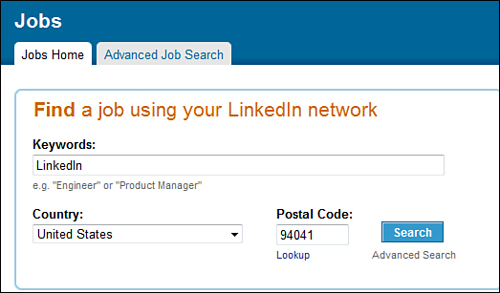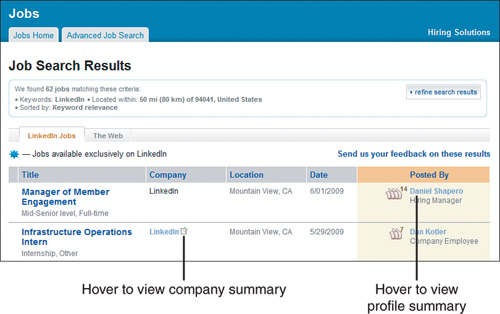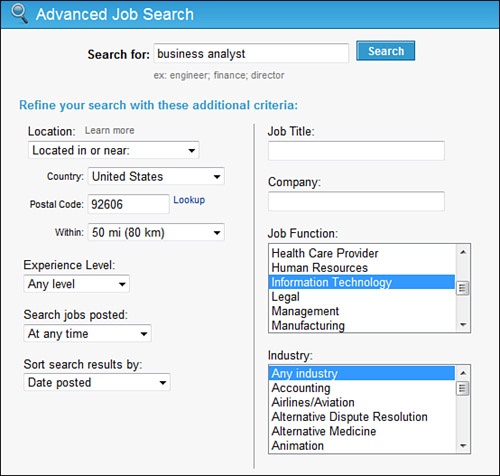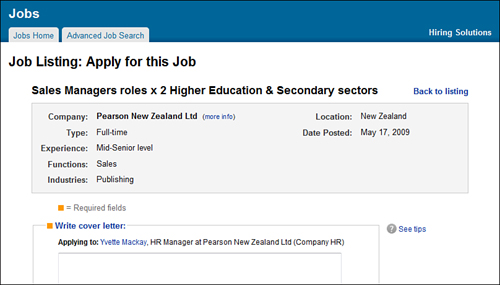In this lesson, you’ll learn how to use LinkedIn as an effective job search tool, find and apply to job postings, and use LinkedIn’s many other features for jobseekers.
LinkedIn is an excellent tool for jobseekers, but you need to create a stellar profile and develop a solid network if you want to maximize your results. Here are seven tips for making the most of LinkedIn as a job search tool.
• Complete your profile. LinkedIn reports that members with a complete profile generate 40 times more opportunities than those whose profiles aren’t complete.
• Develop a solid network of connections. Your ability to use job search features such as JobsInsider or Inside Connections depends on having a reasonable number of connections. You should aim for at least 50 connections to maximize the benefits of these features, although they do work with fewer connections.
• Get recommendations. A complete profile includes at least three recommendations. Aim for recommendations from managers, executives, or actual clients. Peer recommendations, particularly those that you “trade” with colleagues by recommending each other, carry far less weight.
• Include keywords that are relevant to your profession and industry, such as skills, certifications, and degrees. Recruiters search for these words, and your profile should include them if you want to be found.
• Focus on results, not a list of duties. Remember that your profile is a concise summary of your qualifications, not a resume. (Although you can attach one if you like.) Emphasize your results and accomplishments; don’t just list tasks you performed.
• Post a resume or portfolio. Using LinkedIn applications such as Box.net Files, you can attach PDFs to your profile.
• Indicate on your profile that you’re seeking employment. If you’re unemployed, include this information in your status, professional headline, or summary. Don’t sound desperate, but do let your network know that you’re looking for opportunities.
See Lesson 2, “Creating Your Profile,” and Lesson 10, “Requesting and Providing Recommendations,” for more information.
Tip: Clean Up Your Digital Dirt Before Your Job Search
Keep in mind that many recruiters now search the web for background information on potential candidates. It isn’t enough to have a professional presence on LinkedIn. Review any other social networking profiles you have to ensure they also reinforce your professional image. If not, remove your “digital dirt” before you begin your job search. Also, verify that your contacts don’t post photos or other content about you that would compromise your professional reputation.
LinkedIn offers a large database of job postings that are posted directly on LinkedIn and on its partner site, Simply Hired.
Tip: LinkedIn Offers Other Ways to Find Job Postings
Although the Jobs page is LinkedIn’s primary job search tool, you should also search the Jobs Discussion Board for any group you belong to and the Jobs box on the company profiles for your target employers. To do a quick search for jobs, use the search box on the top navigation menu.
To search job postings on LinkedIn, follow these steps:
- Click the Jobs link on the top navigation menu. The Jobs page opens, shown in Figure 9.1.
- In the Find a Job Using Your LinkedIn Network box, enter Keywords related to your job search. For example, you could enter a job title, a job skill, or the name of a target company.
- Select the Country you want to search.
- If applicable, specify a Postal Code to narrow your job search. Leave this field blank to search for jobs nationwide.
- Click the Search button. The Job Search Results page opens, shown in Figure 9.2.
The first tab, LinkedIn Jobs, lists jobs advertised on LinkedIn. On this tab, you can
• Sort jobs by clicking the Title, Company, Location, Date, or Posted By headings.
• Identify jobs that are listed exclusively on LinkedIn (denoted by the blue starburst icon).
• Learn more about the companies that post jobs by hovering your mouse over the company name to open a pop-up with a brief summary of the company (if the company includes the company profile icon to the right of its name; if it doesn’t, then this information isn’t available). Click the View Profile link to open that company’s complete profile.
• Learn more about the job poster by hovering your mouse over the name of the job poster to open a pop-up with a brief summary. Click the View Profile link to open the person’s profile. If no name appears in this field, the company has chosen not to disclose this information.
• Learn more about the job posting (including a job description and application information) by clicking the job title.
The second tab, The Web, lists jobs advertised on the job search site Simply Hired. The format for job listings is similar to the LinkedIn Jobs tab but includes a JobsInsider link for each job. JobsInsider lists the people who work at that hiring company, highlighting those who are in your network. You can also install a JobsInsider toolbar to use when searching popular job sites. See Lesson 8, “Using LinkedIn Tools,” for more information about the JobsInsider toolbar.
Click the Who Do I Know at [Company Name] link to view a list of people in your network who work at this company.
The content listed on a job posting varies according to what the hiring company chooses to display. The content that you see will also vary according to what type of connection you have to the poster and the connections you have to the people working at that company. A job posting (see Figure 9.3) might include some or all of the following features:
• A header listing the job title, location, and company URL.
• A detailed job description.
• The Forward This Job to a Friend link. Click to send a message to a connection who might be interested in this job.
• The Apply Now button. Click this button to apply for the job from LinkedIn. See the “Applying for a Job” section later in this lesson for more information.
• The Request Referral button. Click this button to open the Introductions page where you can request an introduction to the job poster. You can request introductions only to job posters in your network. Otherwise, the Request Referral button doesn’t appear. See Lesson 6, “Communicating with Other LinkedIn Members,” for more information about LinkedIn introductions.
• The Posted By box with a link to the job poster’s LinkedIn profile and recommendations. A connection icon appears if this person is in your network. For example, if a job poster is connected to one of your connections, the 2nd degree connection icon appears. Click the See Who Connects You link to open this person’s profile. On the profile, the How You’re Connected to [First Name] box lists all mutual connections.
• The Inside Connections to the Company box. Click one of the links in this box to display the LinkedIn members in your network who work at this company. These people could provide you inside information about potential job opportunities at the company.
If you want to search for jobs based on specific criteria, try an advanced job search:
- Click the down arrow next to the Jobs link on the top navigation menu and select Advanced Job Search from the drop-down list. You can also open this page by clicking the Advanced Job Search tab on the main Jobs page or by clicking the Advanced link when searching for jobs from the search box on the top navigation menu. Figure 9.4 shows the Advanced Job Search page.
- In the Search For text box, enter keywords (such as a job title, a skill, or a certification). See Lesson 7, “Searching on LinkedIn,” for more information on using advanced search criteria.
- Specify the criteria for your search. Options include the following:
• Location
• Experience Level (ranging from executive jobs to internships)
• Search Jobs Posted (the date the job was posted, such as in the last day or at any time)
• Sort Search Results By (specific criteria such as date posted or location)
• Job Title
• Company name
• Job Function (such as Accounting/Auditing, Engineering, Finance, Information Technology, Marketing, and so forth)
• Industry (such as Banking, Biotechnology, Computer Software, Insurance, Real Estate, and so forth)
- Click the Search button to display job search results.
See the previous section, “Searching Job Postings,” for more information about the Job Search Results page.
You can apply for a job posted on LinkedIn directly from the job description.
Note: Not All Job Application Pages Look the Same
Although the job application process is similar for all jobs, the form you complete isn’t identical for every job you apply for on LinkedIn. In addition, clicking a job title from The Web tab takes you to the Simply Hired website (www.simplyhired.com).
To apply for a job from a LinkedIn posting, following these steps:
- In the job description for the job you would like to apply for, click the Apply Now button and an application page will display. Figure 9.5 shows a sample application page.
- In the Write Cover Letter text box, enter your cover letter. A good cover letter summarizes strengths and accomplishments that are relevant to this job.
- In the Enter Contact Information section, enter details about your name, email address, and contact information.
- Click the Browse button in the Upload Resume section to upload your resume as a text file, Word document, PDF, or HTML file of no more than 200k. LinkedIn attaches your uploaded resume in its original format.
- Preview your profile in the Review Profile section. Make any necessary changes before submitting your application.
- Click the Next button.
- Review and confirm your application one more time before submitting. Be sure to check for spelling, grammar, and content.
- Click the Submit Application button to submit your application for the job.
The good news for jobseekers: Thousands of recruiters and hiring managers maintain profiles on LinkedIn. To find them, select Search People in the quick search box on the top navigation menu. Then click the Advanced link to the right of the box to open the Advanced Search page.
There are several ways to find recruiters and hiring managers on the Advanced Search page. Some examples include the following:
• In the Industry field, select Staffing and Recruiting and enter keywords related to the type of job you’re looking for. Enter location criteria. If your search is nationwide, don’t enter search criteria.
• Enter the title of Recruiter and the name of a Company you want to work for.
• Enter the Title of Recruiter plus relevant location information.
• Enter the name of a Company you want to work for and select Hiring Managers from the Interested In drop-down list.
Searching for appropriate contacts is a combination of art and science, so you might need to revise your search criteria several times before you find the appropriate people.
Caution: Don’t Spam Recruiters and Hiring Managers
Remember that LinkedIn is a networking and research tool, not a means of spamming prospective recruiters and employers. When you do find good targets for your job search, review their profiles carefully to determine the best way to contact them. Some recruiters provide links to external sites for job candidates. If your target is a hiring manager, determine whether you can reach this person through a network introduction. Alternatively, consider sending a brief message to hiring managers who indicate they are open to job inquiries.





